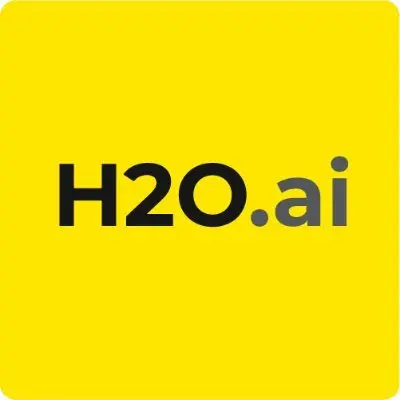AI No-Code Machine Learning Tools
Build, train, and deploy powerful AI models without writing a single line of code. These revolutionary platforms democratize machine learning with drag-and-drop interfaces, automated feature engineering, and one-click deployment, accelerating time-to-insights from months to hours for business users and analysts alike.

DataRobot - no-code machine learning tool
Enterprise AI platform with automated ML lifecycle, from data prep to deployment with visual workflows and explainable AI.

Google Cloud AutoML (Vertex AI) - no-code machine learning tool
Google's unified ML platform with pre-trained models and custom training without code for vision, text, and tabular data.

Microsoft Azure ML Studio - no-code machine learning tool
Drag-and-drop ML studio with pre-built modules, automated ML, and seamless integration with Azure ecosystem.

H2O.ai - no-code machine learning tool
Open-source leader in AutoML with Driverless AI for automated feature engineering and model selection.

Dataiku - no-code machine learning tool
Collaborative data science platform with visual ML, automated workflows, and governance for enterprise teams.

Akkio - no-code machine learning tool
AI analytics platform for business users with instant predictions, easy integrations, and chat-based insights.

Graphite Note - no-code machine learning tool
No-code predictive analytics with pre-built models for common business use cases and white-glove support.
Zams (formerly Obviously AI) - no-code machine learning tool
One-click predictive analytics for sales, marketing, and operations teams with natural language model building.
Teachable Machine (Google) - no-code machine learning tool
Free web-based tool to create ML models for images, sounds, and poses without coding or ML expertise.
MonkeyLearn - no-code machine learning tool
No-code text analytics platform for sentiment analysis, classification, and entity extraction from unstructured data.
Compare No-Code ML Tools
Quick comparison of features and capabilities
| Tool | Best For | Key Features | Pricing | Rating |
|---|---|---|---|---|
| Enterprise AI |
|
Custom | ★★★★★ 4.8 | |
| Google ecosystem |
|
Pay-per-use | ★★★★★ 4.7 | |
| Microsoft users |
|
From $9.99/mo | ★★★★★ 4.6 | |
| Open-source ML |
|
Free/Enterprise | ★★★★★ 4.5 | |
| Team collaboration |
|
Custom | ★★★★★ 4.5 | |
| Quick predictions |
|
From $49/mo | ★★★★☆ 4.4 | |
| Business analytics |
|
From $150/mo | ★★★★☆ 4.3 | |
| One-click ML |
|
From $75/mo | ★★★★☆ 4.2 | |
| Education/prototypes |
|
Free | ★★★★☆ 4.0 | |
| Text analytics |
|
From $299/mo | ★★★★☆ 3.9 |
Note: Choose based on your needs - DataRobot for enterprise AI, Google AutoML for cloud-native, H2O.ai for open-source flexibility, or Akkio for quick business predictions.
Complete Guide to No-Code Machine Learning Tools in 2025
No-code ML platforms are revolutionizing how businesses leverage artificial intelligence, with the global market projected to reach $5.2 billion by 2030 at a 23% CAGR. These platforms empower analysts and business users to create predictive models, automate feature engineering, and deploy at scale without data science expertise. With 78% of analysts reporting model-building time cut by 80% and deployment time reduced by 60%, no-code ML is becoming essential for data-driven organizations.
What Are No-Code Machine Learning Tools?
No-code machine learning tools are software platforms that enable users to build, train, and deploy AI models without writing programming code. These platforms use visual interfaces, drag-and-drop workflows, and automated processes to handle complex ML tasks like data preprocessing, feature engineering, model selection, and hyperparameter tuning. They democratize AI by making machine learning accessible to business analysts, domain experts, and citizen data scientists.
Key Benefits of No-Code ML Platforms
🎯 Drag-and-Drop Model Building
Intuitive visual canvas for designing data pipelines and model workflows. Connect data sources, apply transformations, and build models without coding.
⚙️ Automated Feature Engineering
AI-driven feature selection, transformation, and optimization. Platforms automatically create relevant features from raw data for better model performance.
🚀 Seamless Deployment
One-click deployment to cloud or edge with monitoring. Deploy models as APIs, batch predictions, or real-time services without DevOps expertise.
🔍 Explainable AI
Built-in model interpretability and bias detection for trust and compliance. Understand why models make specific predictions and ensure fairness.
Common Use Cases for No-Code ML Tools
- Customer Churn Prediction: Identify at-risk customers and predict likelihood of cancellation
- Sales Forecasting: Predict future sales trends based on historical data and external factors
- Fraud Detection: Identify suspicious transactions and patterns in real-time
- Demand Planning: Optimize inventory levels with accurate demand predictions
- Lead Scoring: Prioritize sales leads based on conversion probability
- Predictive Maintenance: Prevent equipment failures before they occur
- Price Optimization: Find optimal pricing strategies using ML models
How to Choose the Right No-Code ML Platform
Selecting the perfect no-code ML tool depends on your use case, data complexity, deployment needs, and budget. Here's a comprehensive guide:
For Enterprise AI: DataRobot
DataRobot leads with comprehensive AutoML capabilities, visual workflows, and built-in MLOps. Perfect for large organizations needing production-grade AI with governance.
- Best for: Enterprise teams, complex models, regulated industries
- Strengths: Visual workflow, automated pipeline, explainable AI
- Investment: Custom pricing based on deployment
For Cloud-Native ML: Google Cloud AutoML
Google's Vertex AI provides pre-trained models and custom training for vision, text, and tabular data. Ideal for organizations already using Google Cloud.
- Best for: Google Cloud users, multi-modal AI, edge deployment
- Strengths: Pre-trained models, AutoML Tables, TensorFlow integration
- Investment: Pay-per-use pricing, from $20 per training hour
For Quick Business Predictions: Akkio
Akkio enables 10-minute model building with chat-based interface. Perfect for business analysts needing quick predictions without ML expertise.
- Best for: Business analysts, marketing teams, quick experiments
- Strengths: Fast model building, chat interface, easy API deployment
- Investment: From $49/month for starter plan
For Education & Prototypes: Teachable Machine
Google's free browser-based tool for creating image, sound, and pose recognition models. Ideal for learning ML concepts and building prototypes.
- Best for: Students, educators, proof-of-concepts
- Strengths: Completely free, browser-based, export to TensorFlow
- Investment: Free to use
Best Practices for No-Code ML Success
- Start with Clean Data: Quality data is crucial. Spend time cleaning and preparing your data before model building.
- Define Clear Objectives: Know what you're trying to predict and how you'll measure success before starting.
- Use Domain Knowledge: Leverage business expertise to guide feature selection and model interpretation.
- Validate Thoroughly: Test models on holdout data and real-world scenarios before deployment.
- Monitor Performance: Track model accuracy over time and retrain when performance degrades.
- Consider Explainability: Choose interpretable models when decisions need to be explained to stakeholders.
- Plan for Scale: Ensure your chosen platform can handle production workloads and future growth.
2025 No-Code ML Trends
The no-code ML landscape continues to evolve with exciting innovations:
- AutoML 2.0: Next-generation automated ML with neural architecture search and meta-learning
- Edge ML Deployment: No-code tools for deploying models to IoT devices and edge computing
- Federated Learning: Train models on distributed data without centralizing sensitive information
- AI-Powered Feature Stores: Automated feature engineering with reusable feature libraries
- Real-Time ML Pipelines: Stream processing integration for instant predictions on live data
Market Impact: No-Code ML Statistics
The adoption of no-code ML tools is delivering measurable business impact:
- $5.2 billion global no-code AI market by 2030 (23% CAGR)
- 78% of analysts report model-building time cut by 80%
- 60% reduction in deployment time compared to traditional ML
- 85% of organizations plan to adopt no-code ML tools by 2026
- 3x faster time-to-value compared to traditional data science projects
FAQ: No-Code Machine Learning Tools
What are the best no-code ML tools?
The best no-code ML tools in 2025 include DataRobot (4.8/5 rating) for enterprise AI with visual workflows, Google Cloud AutoML (4.7/5) for cloud-native deployment, H2O.ai (4.5/5) for open-source flexibility, and Akkio (4.4/5) for quick business predictions. Choose based on your needs: DataRobot offers the most comprehensive platform, Google AutoML excels at multi-modal AI, while tools like Teachable Machine provide free entry points for beginners.
How do no-code ML platforms build AI models?
No-code ML platforms automate the entire machine learning pipeline through visual interfaces. They automatically handle data preprocessing, feature engineering, algorithm selection, hyperparameter tuning, and model validation. Users simply upload data, select target variables, and the platform tests hundreds of algorithms and configurations to find the best model. Advanced platforms like DataRobot and H2O.ai use ensemble methods, combining multiple models for superior performance.
Can business users deploy models without data science?
Yes, modern no-code ML platforms enable business users to deploy production-ready models without data science expertise. Platforms provide one-click deployment options to create REST APIs, batch prediction services, or real-time scoring engines. They handle infrastructure provisioning, scaling, monitoring, and model versioning automatically. Tools like Akkio and Zams specifically target business users with simplified interfaces and guided workflows for complete ML lifecycle management.
Which no-code ML tool offers explainability and monitoring?
DataRobot leads in explainability with comprehensive model interpretability features including SHAP values, feature impact analysis, and prediction explanations. H2O.ai's Driverless AI provides similar capabilities with automatic reason codes. For monitoring, platforms like Google Vertex AI and Azure ML Studio offer built-in model performance tracking, data drift detection, and automated retraining. Most enterprise platforms now include bias detection and fairness metrics to ensure responsible AI deployment.
Ready to Build AI Models Without Coding?
Choose the no-code ML platform that matches your needs and expertise level. Whether you need DataRobot's enterprise capabilities, Google AutoML's cloud integration, or Akkio's simplicity, these tools democratize machine learning for everyone.
Start with free trials to experience how no-code ML accelerates your AI journey. Most users report building their first predictive model within hours and achieving 80% faster time-to-insights. Transform your data into predictions—no PhD required.



